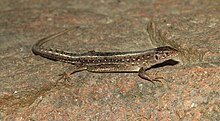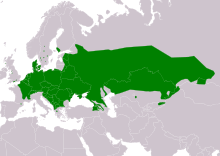
Back سحلية رشيقة Arabic سحلية الرمل ARZ Adi kərtənkələ Azerbaijani Яшчарка порсткая Byelorussian Яшчарка порсткая BE-X-OLD Ливаден гущер Bulgarian Llangardaix pirinenc Catalan Banghitaw CEB Ještěrka obecná Czech Zwëczajnô wieszczórka CSB
| Sand lizard | |
|---|---|

| |
| A male sand lizard | |

| |
| A female sand lizard | |
| Scientific classification | |
| Domain: | Eukaryota |
| Kingdom: | Animalia |
| Phylum: | Chordata |
| Class: | Reptilia |
| Order: | Squamata |
| Family: | Lacertidae |
| Genus: | Lacerta |
| Species: | L. agilis
|
| Binomial name | |
| Lacerta agilis | |

| |
| Range of L. agilis Extant, resident
| |

The sand lizard (Lacerta agilis) is a lacertid lizard. There are several subspecies, including L. a. agilis, L. a. argus, and L. a. exigua.
The sand lizard is distributed across most of Europe from the southern coast of Britain and across the continent to Lake Baikal in Russia.[2][3] It does not occur in European Turkey. Its distribution is often patchy.[4] In the northern extremes of the sand lizard's distribution, it survives by inhabiting seaside heathlands, where the ground temperature is elevated by the sun. The sand lizard uses warm sand to thermoregulate itself and to incubate its eggs.
Males are known for their bright coloration and aggressive, possessive behaviors when seasonally competing for females. In contrast to other squamates, the sand lizard's mating season is very short. Males choose mates selectively, whereas females mate more indiscriminately. Females usually only lay a single clutch of eggs per year.
Sand lizards spend most of their time basking, foraging, or under vegetation. They prefer to live in diverse habitats. They are largely solitary outside of mating season. Male sand lizards typically have larger territories than females, and they will compete with other males when territory overlaps. Females neighbour each other more amicably, occasionally sharing habitats.
Sand lizards may live up to ten years. Due to their longevity, they are sometimes prone to inbreeding.
- ^ Aghasyan, A.; Avci, A.; Tuniyev, B.; et al. (2021). "Lacerta agilis". IUCN Red List of Threatened Species. 2021: e.T157288A49644624. doi:10.2305/IUCN.UK.2021-2.RLTS.T157288A49644624.en. Retrieved 12 November 2021.
- ^ M., Smith (1969). The British Amphibians and Reptiles. Collins, London, UK.
- ^ "Lacerta Agilis LINNAEUS, 1758". www.lacerta.de. Retrieved 30 August 2021.
- ^ Arnold, E. Nicholas; Arribas, Oscar; Carranza, Salvador (2007). "Systematics of the Palaearctic and Oriental lizard tribe Lacertini (Squamata: Lacertidae: Lacertinae), with descriptions of eight new genera" (PDF). Zootaxa. 1430. Auckland, New Zealand: Magnolia Press: 1–86. doi:10.11646/zootaxa.1430.1.1. ISBN 978-1-86977-097-6. Retrieved 12 July 2017.
© MMXXIII Rich X Search. We shall prevail. All rights reserved. Rich X Search
